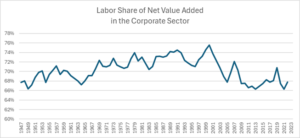April 17, 2024
I was a bit surprised to see a piece on Marketplace radio telling listeners:
“In 1947, U.S. workers got about two-thirds of the income from their labors. ‘Now, they’re getting something that is just a little bit over half. And so they’re getting less of the pie,’ said Erica Groshen, who used to head the Bureau of Labor Statistics and is now at Cornell.”
I was surprised because it’s not true. There have been ups and downs in the labor share of income over this period, but there is no downward trend. In 1947, it was 67.7 percent of net value-added in the corporate sector. In 2023, it was 67.8 percent of net value in the corporate sector. Here’s the picture.

Source: NIPA Table 1.14 and author’s calculation.
As can be seen, there is some rise in the labor share in the sixties and seventies, which is sustained in the eighties and nineties. The labor share then falls back to its late forties level in the first two decades of this century. (This calculation comes from NIPA Table 1.14, Line 4 divided by Line 3.)
It’s true that the typical worker has seen their share of the pie fall, but this is mostly from upward redistribution within the wage distribution. A much larger share of wage income is going to high-end earners, such as CEOS and other top execs, Wall Street types, well-situated STEM workers and protected professionals like doctors and dentists.
This upward redistribution is a huge issue, but we should be clear that most of the story on the before-tax side was highly paid workers pocketing more, not an increase in the profit share. On the after-tax side, because the corporate tax rate has fallen sharply, corporations are taking home a larger share of the pie.







Comments